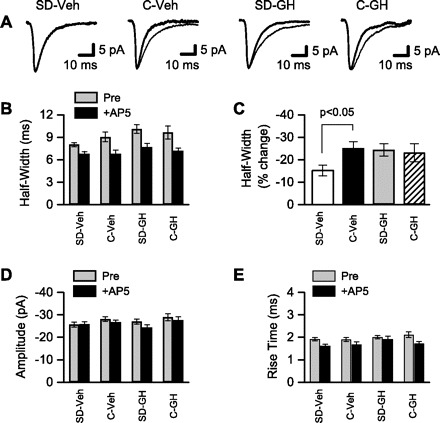Fig. 4.

NMDAR-mediated synaptic currents were reduced after sleep deprivation, but were restored by growth hormone (GH) treatment. Whole cell patch-clamp was used to record sEPSCs. A: averaged sEPSCs from 4 different CA1 pyramidal neurons. sEPSCs were recorded in low-Mg2+ ACSF with GABA receptors blocked (thin line) and after addition of the NMDAR antagonist, d-AP5 (thick line). Recordings are from single neurons in slices from (left to right): SD animals that received daily injections of saline vehicle (SD-Veh), control animals that received daily injections of Veh (C-Veh), SD animals that received daily injections of GH (SD-GH), and control animals that received daily injections of GH (C-GH). The d-AP5-sensitive portion of each sEPSC reflects the NMDAR-mediated component of synaptic current. B: NMDAR-mediated synaptic currents were quantified by measuring sEPSC half-width before and after application of d-AP5. sEPSC half-widths were averaged across all cells from the same treatment condition. sEPSC half-width was minimally affected by d-AP5 in cells (n = 13) from SD-Veh animals, but was substantially reduced in cells (n = 13, 15, 11) from the remaining 3 treatment conditions. C: mean change in sEPSC half-width after d-AP5 application was calculated from the data shown in B. The change in half-width was significantly smaller in the SD-Veh group compared with C-Veh. In contrast, sEPSC half-width was restored to control levels in SD-GH animals. sEPSC amplitudes (D) and rise times (E) are shown. Following block of NMDARs with d-AP5, there were no differences among the 4 groups in sEPSC half-width (B), amplitude (D), or rise time (E), indicating no effect of sleep deprivation or GH on AMPAR function.
